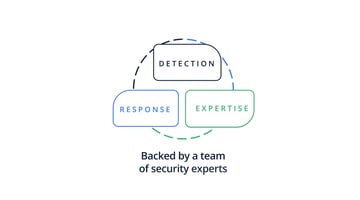A small-to-midsize business cybersecurity checklist can help more compact organizations maintain a constant line of defense against attacks, breaches, and leaks. To stay secure in today’s threat landscape, every growing organization needs to identify the cybersecurity best practices that are important to their specific needs.
That’s because threat actors are getting bolder by the minute, and their new target of choice includes non-enterprise organizations. In fact, 43% of all cyber attacks targeted small to medium-sized businesses in 2022. Clearly, SMBs need to worry about cybersecurity as they’re targeted just as often as large enterprises but must defend themselves with a fraction of the resources. In order to stay protected, lean security teams need to:
- Determine and assess their risk factors.
- Monitor their environments.
- Protect their assets
The following cybersecurity checklist is a simple starting point for resource-strapped teams looking to meet those critical security needs — without breaking the bank or bearing down on their existing security teams.
1. Follow The Right Framework (or Frameworks)
Every cybersecurity program has to start somewhere — but it’s best not to start from scratch. Luckily, cybersecurity has existed long enough as an industry that the most seasoned professionals and experienced institutions have developed several frameworks for smaller security departments to reference when building out defense plans.
The following industry frameworks are highly reputable and can serve as a solid foundation for security teams to branch out from:
2. Develop Incident Response Plans
Unfortunately, breaches are a matter of when, not if in today’s threat landscape. As such, compact security teams must be proactive, not reactive, in their cybersecurity strategies — and that includes creating a preemptive incident response plan.
But what exactly comprises an incident response plan? The main components include:
- Threat identification and containment.
- Protection of critical data.
- Threat elimination and mitigation.
- System restoration.
- Network damage mapping and loss of data integrity.
- Response process auditing and revision.
The key for security professionals aiming to develop incident response plans is to identify what incidents would be devastating to their business in the first place.
Once those incidents are identified, security professionals can create response plans based on those specific scenarios. Then, they can execute test drills and simulations of real attacks to vet the efficacy of their established plan.
Having an incident response plan is like having regular fire drills for buildings. While there isn’t the hope that a building will catch on fire, running fire drills is a method of practicing proactive due diligence. Incident response plans can also help companies determine their specific risk factors and what to do should those risks become actual threats.
You can look to several incident response guides for tips on how to get started.
3. Enable 2FA or Multi-Factor Authentication (MFA)
A major source of attacks on SMBs come from malicious threats masquerading as legitimate users — AKA, exploiting leaked credentials. Compact security teams can implement 2FA or MFA to provide an extra layer of scrutiny when validating the identities of users requesting access.
When non-enterprise organizations use 2FA or MFA on critical assets, they create an additional frontline of security that isn’t compromised by a threat actor finding stray credentials — mitigating the effect of stolen passwords, tokens, or keys. It’s also a way for companies to stay vigilant and monitor who is trying to gain access, when they are attempting a breach, and where they’re located.
4. Create Data Backups
Another way for small and midsize businesses to be proactive in their defense against potential attacks is by creating data backups. However, many of these companies simply don’t have the time, money, or resources to burn in developing backups of entire IT systems. Keep in mind there isn’t necessarily a need to create backups of all data or all workflows, as storing too much data also presents a significant security risk.
Companies with fewer security resources can optimize their strategies and save on unnecessary time and effort by identifying the datasets and workflows that are essential to critical business functions and services — and prioritize creating backups around those assets. This streamlined approach to data backups can keep SMBs up and running and minimize productivity loss, even when attacks do occur.
Data backups are a reactive method of asset protection. While creating backups can preserve important data and processes, companies should also implement proactive, preventative measures.
5. Commit to All-Staff Cybersecurity Education
One such proactive measure is pursuing continuous, all-staff cybersecurity education.
There’s a saying in cybersecurity that your defenses are only as strong as your weakest link. Humans — across the board — are typically the weakest link. According to Verizon’s 2023 Data Breach Investigations Report, 75% of data breaches can be attributed to human error. This includes falling for phishing scams, enabling business email compromises (BEC), and unwittingly unleashing ransomware.
Human error can be costly. In fact, the FBI reports that BECs have cost businesses over $50 billion in the last ten years. That’s why it’s essential for SMBs to develop an all-staff cybersecurity education program.
Not every staff member has to become a cybersecurity genius, but there are a few basics that developing organizations should confidently trust their employees know how to practice. These include:
- Creating strong passwords.
- Identifying (and reporting) phishing emails.
- Safeguarding credentials and sensitive information.
While initial training can be helpful, cybersecurity education programs should also include continual re-training about essential cybersecurity practices — like where to report phishing or spam messages, or how to identify fraudulent requests. SMBs implement continuous cybersecurity education by:
- Sending periodic reminders about password policies
- Sharing information on current phishing tactics seen “in the wild”
- Developing “test” spam emails to gauge all-hands cybersecurity knowledge
6. Find a SIEM Purpose Built for Your Size Organization
It can be difficult for already resource-strained security teams to manually manage every single potential cybersecurity incident or alert that comes their way. That’s why leaner security teams can benefit from a Security Information and Event Management (SIEM) solution that helps catalog and manage cybersecurity data. With the right SIEM, security teams can identify and keep track of the relevant security data that helps determine their risk factors, monitor their environments, and — as a result — protect their assets.
A majority of SIEM solutions on the market are built with large enterprises in mind. As such, they typically require the resources and budget that large enterprises have in order to effectively utilize them.
When lighter security teams use SIEMs developed for large enterprises, they must rapidly address knowledge and resource gaps while also becoming acquainted with their new solution. Traditional SIEMs can take anywhere from several weeks to a few months or even a year to get up and running. This requires time and energy that smaller cybersecurity departments simply do not have access to. As such, small to midsize businesses need a SIEM solution built with businesses of their size and capabilities in mind.
For Robust Defense, Go Beyond a Cybersecurity Checklist
While a cybersecurity checklist can be helpful, agile security teams must pursue best practices one level deeper in order to truly defend themselves from persistent threats. SMBs should approach a checklist as a starting point for their security program as opposed to an end-all, be-all.
Once these checklist items are in place, SMBs should continue to develop further proactive strategies that help keep their sensitive assets out of bad actors’ hands.
One such strategy is staying vigilant of behaviors that indicate an attack or breach might be imminent. To learn more, check out our blog on how detecting behaviors beats zero-days.
More from the blog
View All Posts
The Blumira Value: Easy Detection, Response & Expertise
Read More
Tom Lawrence Tests Blumira’s SIEM Platform
Read More
Cybersecurity Innovator Blumira Bolsters Executive Team for Next Growth Phase
Read MoreSubscribe to email updates
Stay up-to-date on what's happening at this blog and get additional content about the benefits of subscribing.

